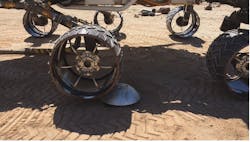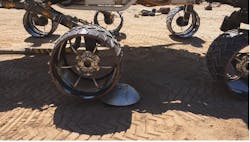The Mars Curiosity rover, which soft-landed on that planet on Aug. 6, 2012 after being lowered by a dramatic “sky crane” system, was expected to have a viable lifetime of one to two years on the planet’s surface. Likely sources of failure included the rover's various onboard mechanisms, its batteries, and its 110-W, nuclear-powered radioisotope thermoelectric generator (RTG). Amazingly, the rover is still functioning fairly well after five years, exploring farther and farther from the landing spot, and deliberately being directed through more-challenging terrain.
But those extra travels are spurring another problem that was originally not a concern. The treads on its wheels are wearing out from the extra distance traveled, and even more so due to climbing over sharp-edged rocks and other obstacles. Since tire replacement is certainly not an option, two researchers at the Jet Propulsion Laboratory (JPL), which manages the mission for NASA, instead developed an algorithm that should extend tread life. After 18 months of testing on Earth, the new wheel-drive software was uploaded in March and approved for use by project management in June.
The tread-wear problem is primarily due to uneven ground. On level ground, all of the rover's six wheels (three on each side) obviously turn at the same speed. On uneven terrain, however, any incline causes one or more of the wheels to start slipping relative to other wheels.
Further, when an individual wheel is traversing pointed, embedded rocks, the wheels in front pull the trailing wheels into rocks and the rear wheels push the leading wheels into rocks. Thus, the climbing wheel can end up experiencing higher forces, leading to cracks and punctures. While the tread sections on the wheels are designed for climbing rocks, the spaces between them are more at risk.
An Earth-based duplicate of the Mars Curiosity rover drives over a sensor as part of the evaluation of a new wheel-control algorithm designed to reduce wear on the rover’s tread sections and so extend tire life. (Credit: NASA/JPL-Caltech)
Each aluminum wheel is about 20 inches (50 cm) in diameter and about 16 inches (40 cm) wide. A January photo showed no major damage, but a subsequent March 19 photo revealed that the middle left wheel had two broken tread sections. When three of these tread sections—called grousers—are broken, NASA feels that the wheel has reached about 60% of its useful life.
The improved traction-control algorithm adjusts each wheel's speed based on real-time data, measuring changes to the suspension system to determine the contact points of each wheel. It then calculates the correct speed to avoid slippage, improving the rover's traction.
In Earth-based tests, the wheels were driven over a 6-in. (15-cm) force-torque sensor on flat terrain (see figure). Using the new algorithm, the leading wheels experienced a 20% load reduction, while middle wheels experienced an 11% load reduction.
The algorithm also addresses the problem of “wheelies,” where a climbing wheel keeps rising and eventually lifts high enough off the surface of a rock to spin freely. The resultant loss of contact of that wheel increases the forces on the wheels that are still in contact with terrain, thus increasing their wear. When the new algorithm detects a wheelie’s occurrence, it adjusts the speeds of the other wheels until the rising wheel comes back into contact with the ground.
Everything about the Mars Curiosity mission has been astonishing, especially its radical “sky crane” approach to the landing, and is detailed in the 2016 book The Right Kind of Crazy: A True Story of Teamwork, Leadership, and High-Stakes Innovation. Written by Adam Steltzner (who led the Entry, Descent, and Landing team) and William Patrick, the book covers the overall mission, but focuses on how the “it can’t possibly work” sky-crane landing idea was conceived, “sold” internally, simulated, implemented, and successfully executed after an eight-month journey.
References
https://www.jpl.nasa.gov/news/news.php?feature=6887
https://www.nbcnews.com/mach/space/nasa-s-curiosity-mars-rover-showing-its-age-s-not-n740541
https://forum.nasaspaceflight.com/index.php?topic=31913.0
https://www.nasa.gov/mission_pages/msl/news/msl20120805c.html
https://www.space.com/16679-mars-rover-curiosity-nuclear-power-lifespan.html
About the Author

Bill Schweber
Contributing Editor
Bill Schweber is an electronics engineer who has written three textbooks on electronic communications systems, as well as hundreds of technical articles, opinion columns, and product features. In past roles, he worked as a technical website manager for multiple topic-specific sites for EE Times, as well as both the Executive Editor and Analog Editor at EDN.
At Analog Devices Inc., Bill was in marketing communications (public relations). As a result, he has been on both sides of the technical PR function, presenting company products, stories, and messages to the media and also as the recipient of these.
Prior to the MarCom role at Analog, Bill was associate editor of their respected technical journal and worked in their product marketing and applications engineering groups. Before those roles, he was at Instron Corp., doing hands-on analog- and power-circuit design and systems integration for materials-testing machine controls.
Bill has an MSEE (Univ. of Mass) and BSEE (Columbia Univ.), is a Registered Professional Engineer, and holds an Advanced Class amateur radio license. He has also planned, written, and presented online courses on a variety of engineering topics, including MOSFET basics, ADC selection, and driving LEDs.


